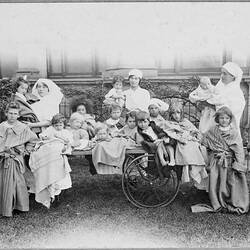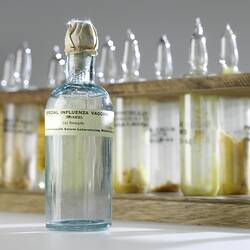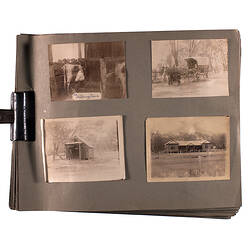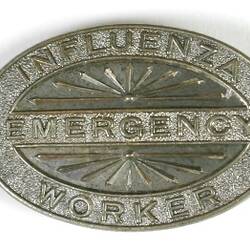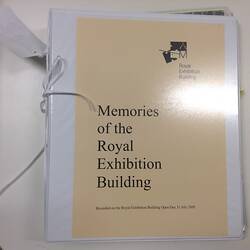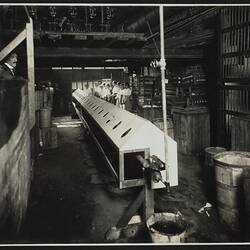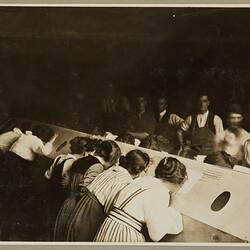At the end of World War I, returning soldiers brought back to Australia one of the most dangerous viruses ever known: the 'Spanish flu'. It was caused by an H1N1 virus of avian origin. It had not originated in Spain, but was first reported there since Spain had less media restrictions than some nations due to the war. It may have originated in military camps in the USA. It first circulated amongt troops, causing additional pressure on hospitals already coping with the casualties of war. It is thought that around one-third of the world's population may have been clinically effected, and around 40 million people died.
In Melbourne the first cases were seen in late January. By the end of that year, tens of thousands had fallen ill. Nearly 2500 people died.
Temporary hospitals opened in the Exhibition Building and some schools. Cinemas, schools, racecourses and other public places were closed in an attempt to reduce the spread of infection. Face masks to limit the spread of airborne pathogens were worn by some front-line workers including medical personnel, bank workers and tram conductors.
The Commonwealth Serum Laboratories (CSL) had been established during World War I to produce local biopharmaceuticals when Australia was cut off from its sources of vaccines and other bacteriological products. When the Spanish flu arrived in Australia in early 1919, CSL produced millions of doses of a mixed bacterial vaccine to try to combat the pandemic. It did not work because - unknown to the researchers - Spanish flu was a virus.
CSL later became famous for its work in the areas of penicillin, insulin, antivenoms, vaccines and blood products. It remains a highly successful Australian business and is today working to develop vaccines for dangerous new strains of influenza.
References
Department of Health, Australian Government, https://www1.health.gov.au/internet/main/publishing.nsf/Content/about-pandemic-history, accessed 21/4/2020.
'Diseases and Epidemics', Encyclopedia of Melbourne, http://www.emelbourne.net.au/biogs/EM00473b.htm, accessed 21/4/2020.
J. K. Taubenberger, 2006. 'The Origin and Virulence of the 1918 "Spanish" Influenza Virus'. Proc Am Philos Soc. 2006 Mar; 150(1): 86-112.
More Information
-
Keywords
Acquired Immune Deficiency Syndrome (AIDS), Healthcare & Medicine, Hospitals, Infectious Diseases, Medical Institutions, Medical Research, Polio (Poliomyelitis), Sexually Transmitted Diseases (STDs), Influenza, Influenza Epidemic, 1919
-
Localities
-
Authors
-
Article types

